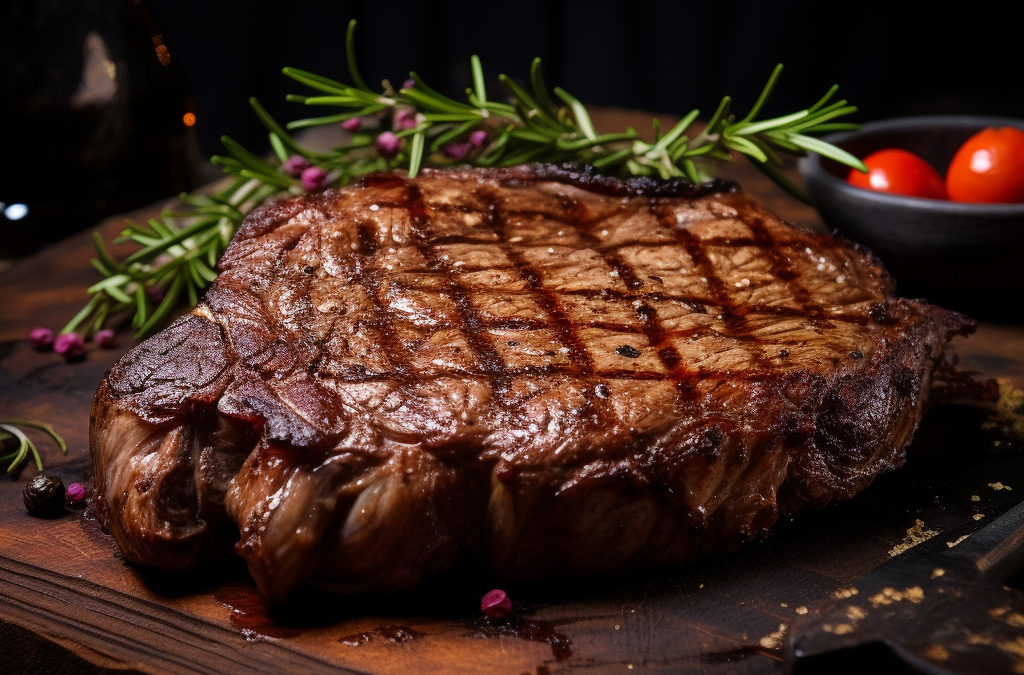The ribeye steak is a pinnacle of culinary delight, revered by chefs and meat lovers for its rich flavor and succulent tenderness. This comprehensive guide is crafted for restaurateurs, steak aficionados, and culinary professionals who seek to deepen their understanding of this premium cut. From its anatomical origins to the subtleties of preparation and presentation, we will delve into the nuances that make the ribeye a true gastronomic treasure. Whether sourcing the finest cuts for your business or perfecting your grilling technique, these revelations will enhance your appreciation and mastery of the ribeye, ensuring that every meal is an exceptional experience.
Understanding the Ribeye Cut
The ribeye steak is a pinnacle of culinary delight and garners admiration for its rich flavors and supreme tenderness. Nestled within the rib section of the cow, the ribeye spans from the sixth to the twelfth rib, a location that contributes to its luxurious qualities.
Delving into the variations of the ribeye, we encounter the classic bone-in ribeye, also known as the rib steak. This variant boasts a bone that aficionados argue imparts additional savor during cooking. In contrast, the boneless ribeye offers a different experience focusing on the meat itself, showcasing the marbling synonymous with flavor and moisture.
The essence of the ribeye’s flavor profile lies in its marbling, the delicate pattern of fat woven through the muscle. As the steak cooks, this fat renders, infusing the meat with a rich taste and ensuring a tender bite. The presence and quality of marbling are pivotal, setting the standard for beef grading and serving as a crucial indicator when selecting a ribeye.
A ribeye with abundant marbling promises a memorable meal and signifies the animal’s quality of life and diet. The visible marbling is a harbinger of the steak’s potential, hinting at the culinary experience to come.
Two primary muscles constitute the ribeye: the longissimus dorsi, which gives the steak its heft, and the spinal, or ribeye cap. With its heightened fat content and softness, the latter is often celebrated as the most delectable steak segment by culinary experts.
With this exploration of the ribeye’s beginnings, structure, and the interplay of its internal fats, it’s evident why this cut is held in such high esteem by butchers and steak lovers. Its sumptuous taste, velvety texture, and generous marbling are the hallmarks of gastronomic indulgence.
Grasping the intricacies of the ribeye cut lays the groundwork for refining our skills in its selection, preparation, and ultimate savoring. Armed with this understanding, steak enthusiasts and chefs alike can steer their way to a ribeye that not only pleases the palate but also graces their dining experience with distinction.
Origin and Anatomy of the Ribeye
The ribeye’s moniker is a nod to its origin in the bovine’s upper rib cage, a region spared from heavy labor, thus ensuring the meat’s inherent softness.
The ribeye’s most traditional form is born from the ‘prime rib’ roast. When this roast is sliced into steaks before cooking, it yields the esteemed rib steak, bone intact. Meat experts call this primal cut the beef rib, designated IMPS/NAMP 109.
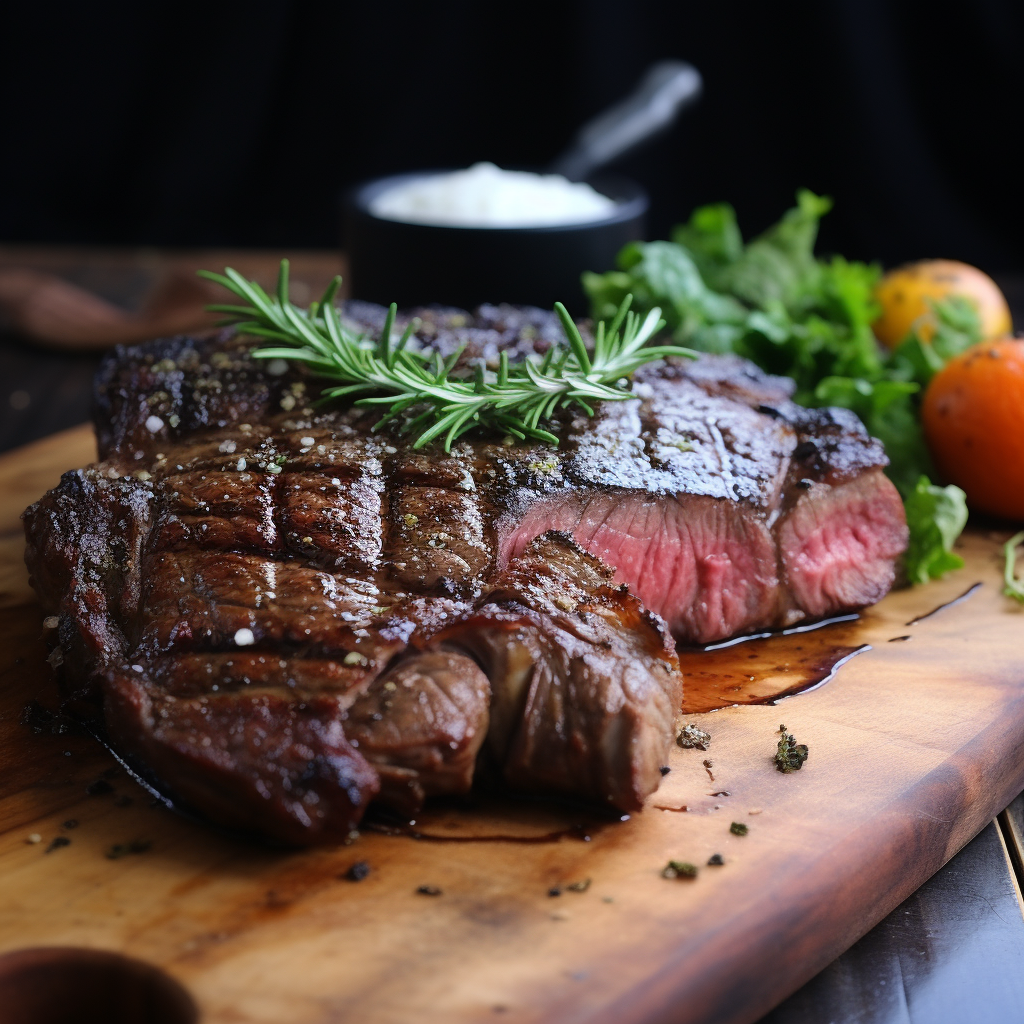
The ribeye’s gastronomic acclaim is mainly due to its two main components: the longissimus dorsi and the spinalis. The former, a sizable muscle encased in a thick fat cap, can be trimmed to taste. This muscle runs along the spine and is minimally exerted, contributing to its melt-in-your-mouth quality.
Conversely, the spinalis muscle graces the longissimus dorsi’s outer edge, which is smaller yet equally impactful. Celebrated for its fine texture and rich marbling, it often becomes the highlight for those who relish a good steak.
The presence and proportion of these muscles and the distribution of fat and connective tissue define the ribeye’s character. A pronounced spinalis, for example, indicates a steak that will deliver a burst of flavor and a pleasurable mouthfeel.
Beyond the classic bone-in and boneless options, the ribeye presents in other enticing forms. The ‘ribeye cap,’ for instance, can be rolled and tied, resulting in a visually stunning and flavor-packed cut that exemplifies the luxury of premium beef.
The ribeye’s anatomy is a symphony of tender muscles and luscious marbling, each contributing to a robust and succulent dining experience. A deeper appreciation of these elements empowers the culinary professional and the discerning diner to select and prepare a steak that epitomizes epicurean excellence.
Marbling: The Key to Flavor and Tenderness
The allure of a ribeye steak lies in its intricate marbling, the delicate web of intramuscular fat that weaves through the beef. This marbling is not merely a visual delight; it’s the cornerstone of the steak’s flavor profile and buttery tenderness.
As the ribeye cooks, the marbling melts, basting the steak from within; this natural process imbues the meat with a sumptuous flavor that is robust and unmistakably beefy. The resulting texture is a tender, melt-in-your-mouth experience that is highly sought after by connoisseurs.
Uniformly distributed marbling ensures that each bite is succulent, even when subjected to higher temperatures. While personal preference dictates the ideal level of doneness, many aficionados suggest stopping at medium to safeguard the steak’s moisture and the integrity of its marbling.
The marbling pattern is also a telltale sign of the steak’s quality, a topic that will be expanded upon in the following sections. Influenced by various factors, including breed, diet, and farming practices, marbling remains a pivotal aspect of the ribeye, guiding selection, and culinary technique.
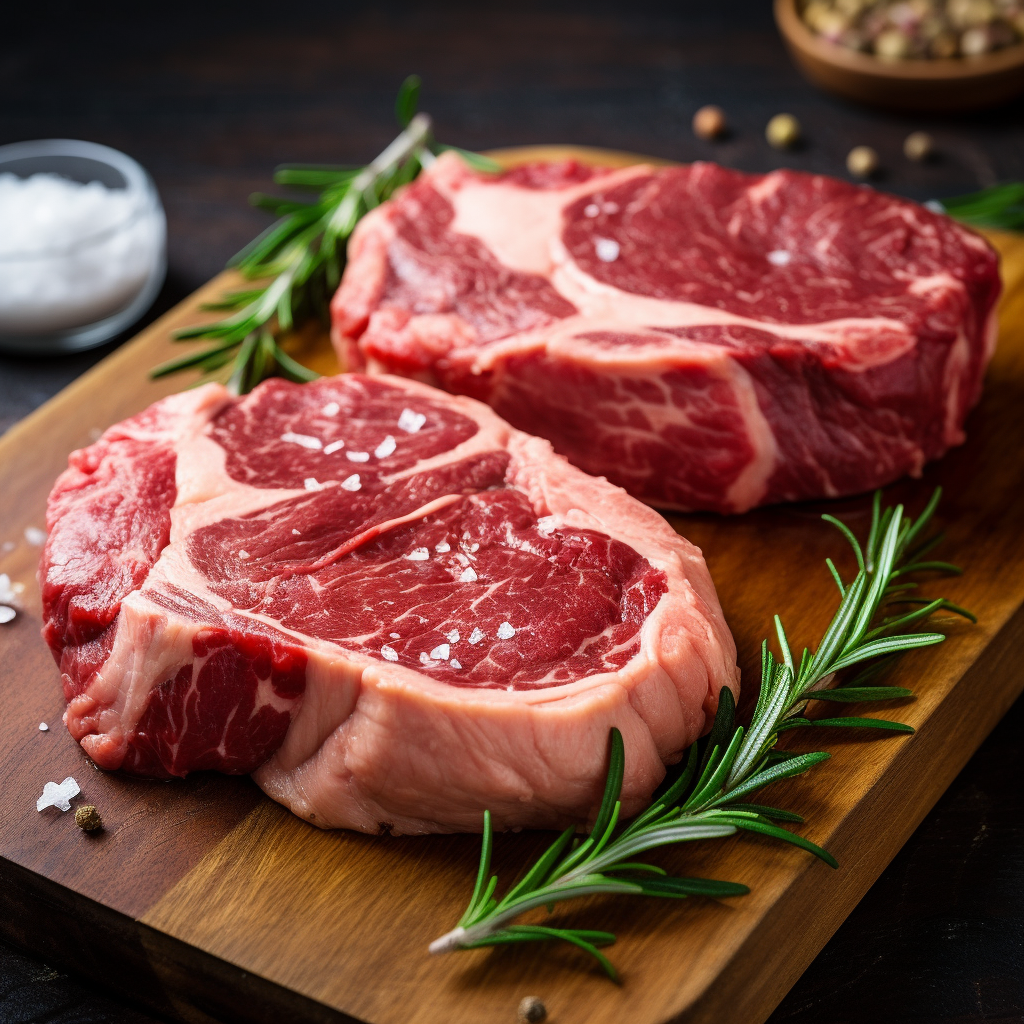
Selecting the Best Ribeye
The quest for the ultimate ribeye is an exercise in discernment, where knowledge of marbling intertwines with other critical factors. Beyond the marbling, which we’ve established as a flavor enhancer, there are additional aspects to consider to procure the finest cut.
Beef Grading and What it Means for Ribeye
The USDA’s beef grading system evaluates meat based on marbling and maturity, among other criteria. For ribeye enthusiasts, the grades to remember are Prime, Choice, and Select, with Prime being the epitome of marbling and tenderness. A Prime-grade ribeye promises an indulgent meal, while Choice and Select offer varying marbling and tenderness.
The Impact of Aging on Ribeye Quality
Aging plays a pivotal role in the ribeye’s quality. Wet aging, the more prevalent method, involves vacuum-sealing the meat, resulting in a tender steak with a subtle flavor. Conversely, dry aging allows the meat to mature in a controlled environment, intensifying its flavors and enhancing tenderness. Choosing between wet and dry aging is subjective, but dry-aged ribeye is often lauded for its flavor profile.
When handpicking a ribeye, visual cues are invaluable. A steak with a rich red hue and a substantial thickness promises a juicy, evenly cooked result. While a fat rim is customary, an excess can diminish the edible portion. The spinalis, or ribeye cap, should display pronounced marbling, a hallmark of a superior cut.
Selecting the perfect ribeye is a blend of understanding grades, aging preferences, and visual assessment. These elements pave the way to a sublime ribeye experience when carefully considered.
Beef Grading and What it Means for Ribeye
Navigating the world of beef grading can be akin to understanding a fine wine’s ranking—it’s essential for discerning the anticipated pleasure of a ribeye steak. The USDA’s grading system acts as a compass for consumers, pointing towards the expected succulence and flavor of the meat. Within this framework, marbling and maturity are the stars by which ribeyes are navigated.
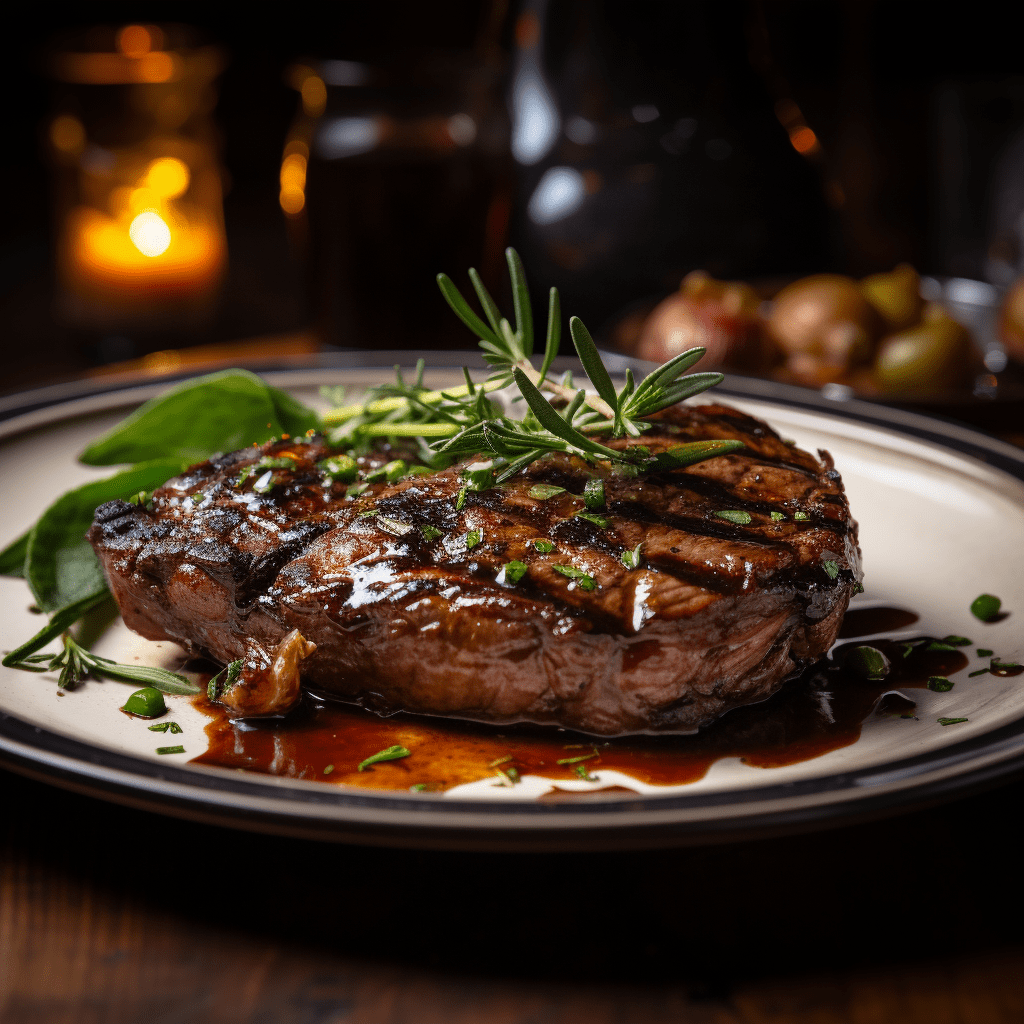
USDA Prime is the zenith of this constellation, with its rich marbling ensuring a sumptuous and tender ribeye, a treasure typically found in the dining rooms of luxury establishments and gourmet butchers. A step below, USDA Choice still promises a delightful harmony of taste and texture, while USDA Select offers a more accessible option, though it may require a deft touch in the kitchen to bring out its best.
While less prevalent, there are additional grades such as USDA Standard and Commercial, down to Utility, Cutter, and Canner—these often end up in processed foods and are less suited for those seeking the zenith of a ribeye experience.
It’s important to note that the USDA’s shield of grading is not mandatory, but service meat processors can opt for it to assure customers of quality. Ungraded beef, therefore, does not necessarily mean inferior quality; it may simply mean the ribeye comes from a source that relies on its reputation rather than a federal stamp of approval.
While marbling is the linchpin in the grading process, other factors, such as the meat’s firmness, texture, and color, are also considered. Yet, for ribeye enthusiasts, the marbling most indicates a memorable meal.
With knowledge of these grades, consumers can tailor their purchases to their taste and budget, ensuring that each ribeye steak meets their benchmark for an exceptional culinary experience.
The Impact of Aging on Ribeye Quality
The art of aging is a transformative process that elevates a ribeye from merely good to exceptional. It’s a culinary alchemy that works magic through enzymes, which tenderize the meat and amplify its inherent flavors.
There are two primary aging techniques: wet and dry. Wet aging involves sealing the ribeye in airtight packaging, allowing it to tenderize in its natural juices over several days to weeks. This method preserves the steak’s moisture, yielding a succulent cut with a pure flavor profile. Moreover, it’s an economical choice since there’s no weight loss from moisture evaporation.
Dry aging, in contrast, is a time-honored technique where the steak is exposed to the air in a controlled environment. This method allows the meat to dehydrate slightly over time, forming a crust that is trimmed away to reveal a ribeye that’s rich and robust in flavor, with a tenderness that melts in your mouth. The process results in some weight reduction, reflected in the steak’s premium status and price point.
The duration of aging, whether the more modern wet method or the traditional dry approach, profoundly impacts the ribeye’s quality. Gourmets and chefs often favor the complex flavors and sublime texture of well-aged beef, particularly the dry-aged variety, celebrated for its unique depth and character.
By understanding the nuances of aging, steak aficionados can select ribeyes that align with their preferred flavor profiles and textures, further enhancing the gastronomic delight of this esteemed cut.
Mastering Ribeye Preparation
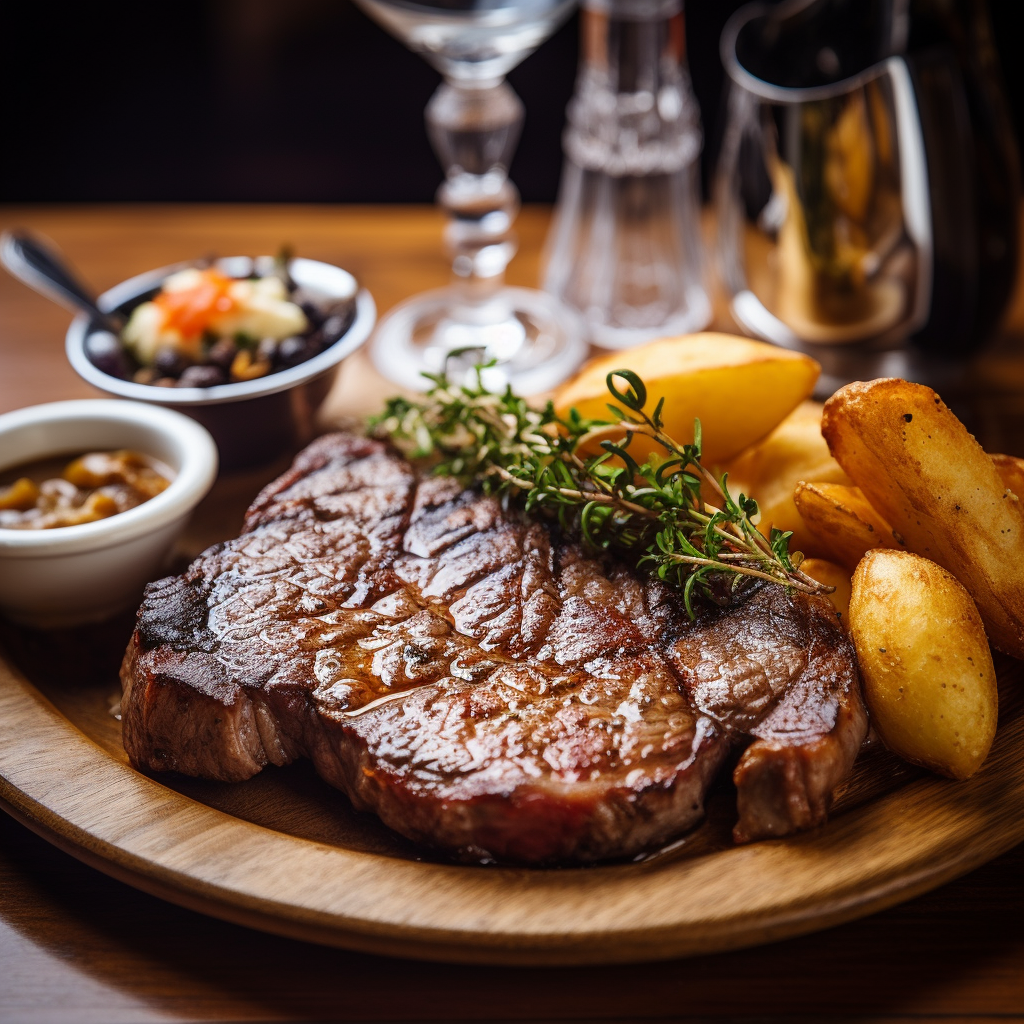
The journey to a sublime ribeye feast begins with mastering the art of cooking this esteemed cut. The ribeye, celebrated for its succulent marbling and robust flavor, demands a cooking approach that accentuates these inherent qualities without overwhelming them.
Grilling Ribeye to Perfection
Grilling is a time-honored method that imbues ribeye with a distinctive charred essence, enhancing the beef’s natural richness. To grill a ribeye to its full glory:
- Ignite your grill, setting it to a blazing high temperature to guarantee a sizzling sear and those coveted grill marks.
- Simple seasoning is critical; let the steak’s innate flavors shine with a sprinkle of salt and cracked black pepper.
- Lay the steak on the grill’s hottest zone to sear, giving each side a few minutes to develop a crust.
- Transition the steak to a more relaxed area of the grill, continuing to cook it to your preferred level of doneness—options like rare to medium are typically favored.
- Allow the steak a brief respite after grilling, a pause of 5-10 minutes, to let the juices settle and ensure each bite is as flavorful as possible.
The Art of Pan-Searing Ribeye
For those who favor the indoors or lack a grill, pan-searing is a superb alternative that achieves a delectable crust akin to grilling. To pan-sear a ribeye:
- Begin by patting the steak dry, which aids in achieving an even, golden sear.
- Heat a sturdy skillet, such as cast iron, to a high temperature and introduce a splash of oil with a high smoke point.
- After seasoning, place the ribeye in the skillet, letting it sear undisturbed to form a flavorful crust.
- Once seared, adjust the heat to gently bring the steak to your desired internal temperature, perhaps adding a touch of butter and herbs like rosemary or thyme towards the end for an aromatic finish.
- Rest the steak similarly to the grilled method, ensuring a moist and tender result.
Both grilling and pan-searing are high-heat strategies that capitalize on the ribeye’s fat and flavor profile. When done with precision, these methods yield a feast that is a testament to the cut’s celebrated characteristics. A trusty meat thermometer is your ally in this process, ensuring the steak reaches the perfect point of doneness without compromising its juiciness.
Grilling Ribeye to Perfection

Grilling ribeye steaks is an art that, when perfected, can turn a simple meal into an extraordinary event. To achieve that quintessential combination of a caramelized crust with a succulent interior, consider these refined steps:
- Room temperature rule: Remove the ribeye from the refrigerator about 30 minutes before grilling to promote even cooking.
- Grill readiness: Heat the grill to a robust 450-500 degrees Fahrenheit, preparing for direct and indirect cooking zones.
- Liberal seasoning: A generous application of coarse salt and freshly ground pepper is warranted by the ribeye’s thickness, aiding in crust formation.
- Oil for success: A light brush on the steak just before grilling can help prevent sticking and enhance the searing process.
- Searing stage: Position the ribeye on the grill’s hottest part for a few minutes on each side to establish a well-defined crust. Minimize movement to ensure distinct grill marks.
- Transition to indirect heat: After searing, move the steak to a more excellent section of the grill to continue cooking the interior to perfection without charring the exterior.
- Doneness diligence: Employ a meat thermometer to monitor the internal temperature. Aim to remove the steak from the grill at approximately 135 degrees Fahrenheit for a medium-rare finish, allowing for a slight rise in temperature as it rests.
- Rest and reward: Let the steak rest on a warm plate for a duration that’s about half of its grill time. This pause is crucial for redistributing the juices, guaranteeing a moist and tender experience with every slice.
In the final moments of grilling, you might enhance the flavor further with a dab of butter or a sprig of aromatic herbs, which infuse the meat as it completes its cooking journey.
Adhering to these steps showcases the ribeye’s celebrated marbling and imparts the unique, smoky flavor only grilling can provide.
The Art of Pan-Searing Ribeye
Pan-searing is a culinary technique that transforms the ribeye into a delectable masterpiece, accentuating its inherent flavors and textures. To achieve a flawless sear, follow these steps:
- Preparation is vital: Allow the ribeye to reach room temperature, ensuring uniform cooking. Dry the surface thoroughly to enhance the searing process.
- Selecting the ideal pan: Opt for a heavy cast-iron skillet, renowned for its superior heat retention and even distribution. Heat the skillet until it’s sizzling hot, a crucial step for achieving that coveted crust.
- Seasoning matters: Generously season with salt and freshly ground black pepper, considering the steak’s thickness and capacity for bold flavors.
- Oil with a high smoke point: When the skillet is ready, add enough oil to coat the bottom, choosing an oil that can withstand high temperatures without smoking.
- Sear with confidence: Carefully place the ribeye in the skillet, searing it undisturbed to allow a rich, golden crust to form, a testament to the Maillard reaction at work.
- A single flip: Once the first side is beautifully bronzed, use tongs to turn the steak. Please resist the urge to flip it repeatedly, as this can prevent the crust from developing correctly.
- Manage the heat: Lower the heat if needed after searing both sides. This prevents charring and ensures the steak cooks to your preferred internal temperature.
- Basting for added flavor: In the final cooking moments, baste the ribeye with butter and add aromatic garlic cloves and fresh herbs like thyme or rosemary to infuse the meat with additional flavors.
- Testing for doneness: Use a meat thermometer to check for your desired level of doneness, typically around 135 degrees Fahrenheit, for a medium-rare finish.
- Resting is crucial: Let the steak rest for about half the time it was cooked to allow the juices to redistribute, ensuring each bite is as juicy as the last.
Mastering the pan-sear is about understanding the interplay of heat, timing, and flavor. It’s a simple yet sophisticated method that, when executed well, showcases the ribeye’s luxurious qualities.
Enhancing the Ribeye Dining Experience
Elevating a ribeye meal to a gastronomic delight involves more than just the steak; it’s about curating a symphony of accompaniments and libations that complement its robust flavors.
Accompaniments that Elevate the Ribeye
To balance the rich taste of the ribeye, consider these side dishes:
- Roasted vegetables: A medley of seasonal vegetables, such as sweet carrots, tender asparagus, or earthy Brussels sprouts, roasted to caramelized perfection, can provide a delightful contrast to the steak’s richness.
- Garlic mashed potatoes: Silky and rich, with a subtle garlic infusion, these potatoes are a classic pairing that melds seamlessly with the steak’s juiciness.
- Steak sauces: For those who enjoy an extra dimension of flavor, a drizzle of béarnaise, a peppercorn kick, or a velvety red wine reduction can amplify the ribeye’s natural savoriness.
The right sides add visual appeal and nutritional balance, creating a tapestry of flavors and textures that enhance the ribeye’s starring role.
Wine Pairing with Ribeye
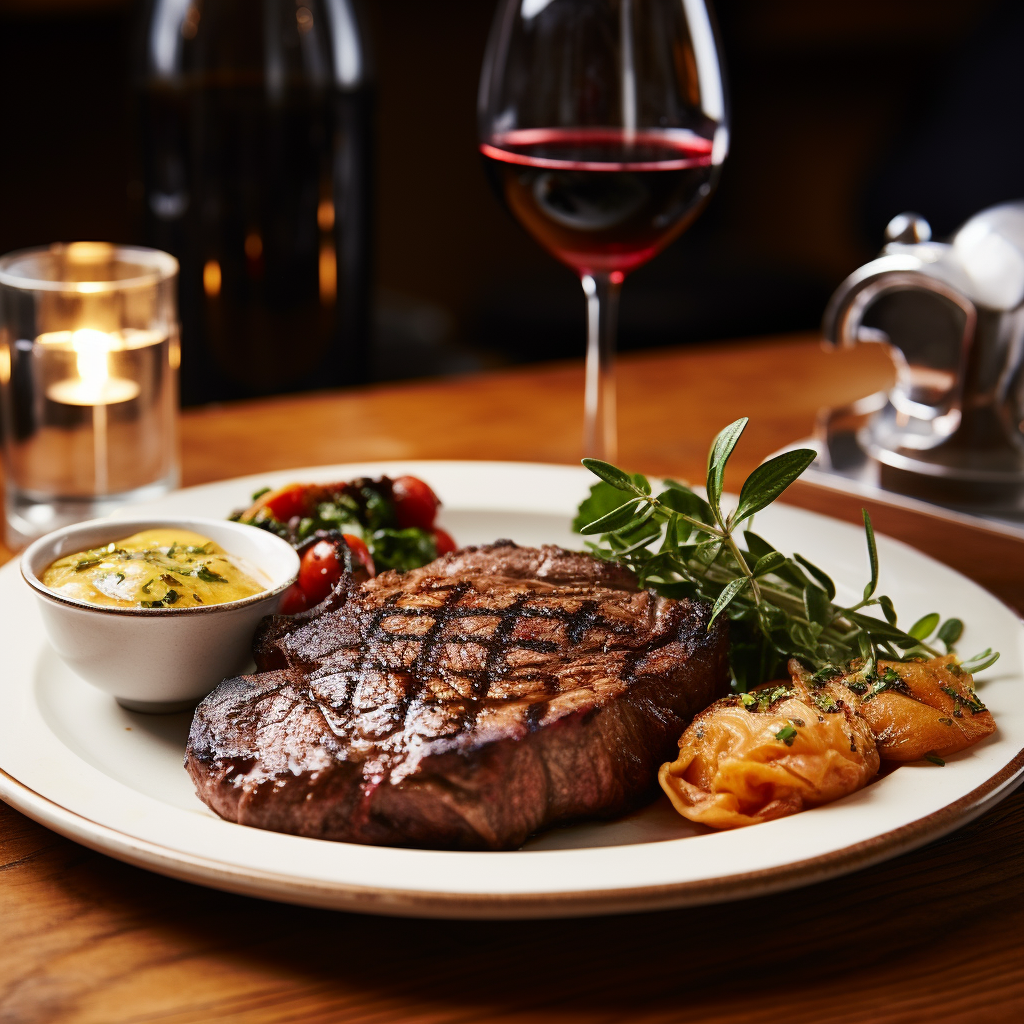
Choosing the perfect wine to accompany a ribeye matches intensity and structure. Robust reds like Cabernet Sauvignon, Syrah, or Malbec, with their bold tannins, are classic companions that refresh the palate and stand shoulder to shoulder-with the steak’s hearty flavors.
For a lighter touch, a full-bodied Chardonnay with a touch of oak can offer a creamy counterpoint to the steak’s texture, presenting an alternative yet equally satisfying pairing.
Wine pairing is deeply personal, and the best choice is one that delights your palate. The aim is to create a seamless interplay between the steak, its accompaniments, and the wine, each enhancing the other to craft an unforgettable dining experience.
Considering these considerations, dining on ribeye becomes an occasion to savor, a feast for the senses that lingers long after the last bite.
Accompaniments that Elevate the Ribeye
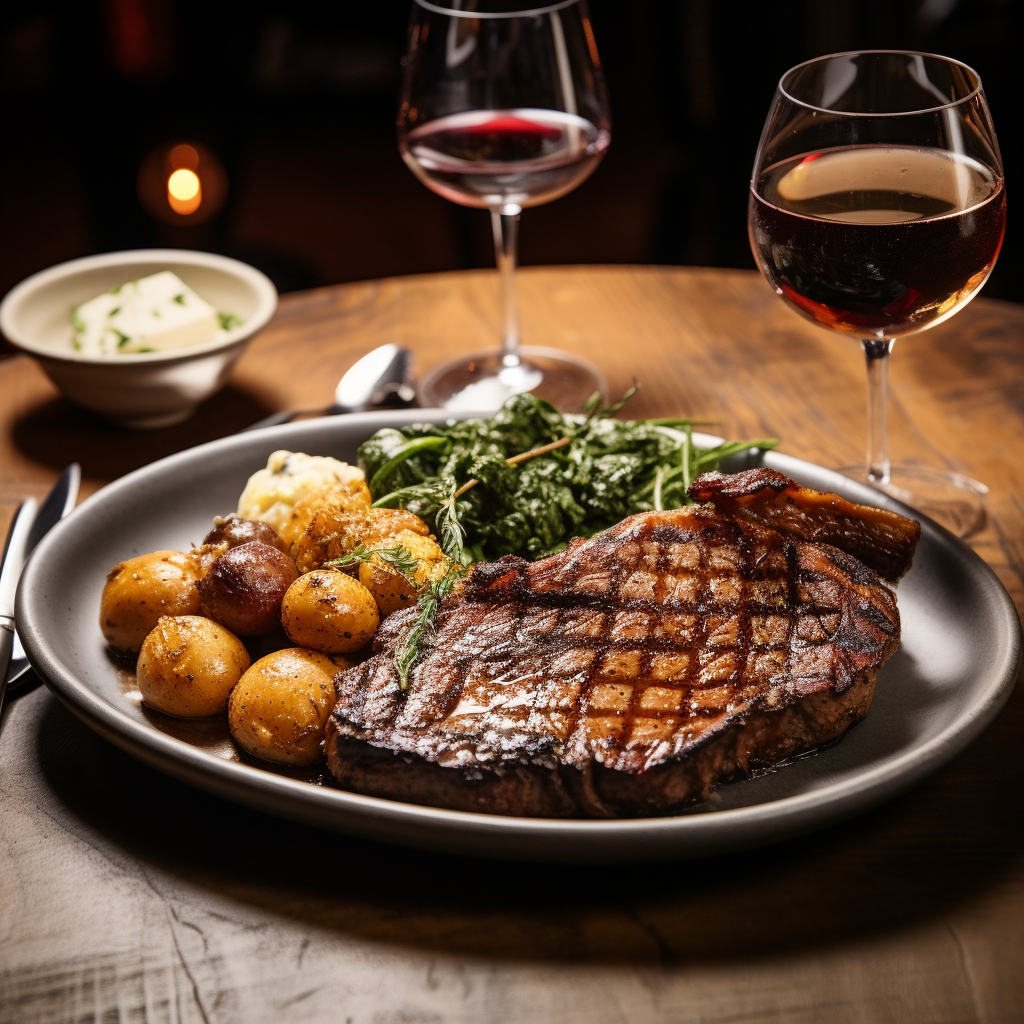
To craft an unforgettable ribeye feast, it’s essential to pair the main attraction with sides that enhance its rich taste without overshadowing it. Consider these exemplary choices:
- Roasted Root Vegetables: A medley of roasted root vegetables, such as carrots, turnips, and rutabagas, introduces a subtle sweetness and earthiness that contrasts delightfully with the steak’s savory depth.
- Creamed Spinach: This velvety side dish, with just a whisper of garlic and a luxurious cream base, provides a smooth complement to the ribeye’s texture.
- Garlic Butter Mushrooms: Earthy mushrooms, when sautéed in a garlic-infused butter, echo the meaty essence of the ribeye, enhancing its natural umami.
- Crispy Shallots: Offering a crunchier alternative to onion rings, crispy shallots bring a delicate yet sharp sweetness, juxtaposing the steak’s robust profile.
- Herb-Infused Blue Cheese Butter: A pat of blue cheese butter, laced with herbs like tarragon or oregano, melts into the steak, marrying the cheese tang with the meat’s richness.
- Chimichurri or Béarnaise: For those seeking a brighter complement, a zesty chimichurri or a tarragon-infused Béarnaise sauce can cut through the ribeye’s richness with its vibrant, herbaceous flavors.
The goal is to curate a symphony of flavors where each side plays in harmony with the ribeye’s succulent marbling and tender profile, ensuring a dining experience that’s both balanced and memorable.
Wine Pairing with Ribeye
A well-chosen wine can elevate the ribeye steak from a mere meal to a culinary event. Here are varietals that promise to complement the steak’s luxurious flavors:
- Cabernet Sauvignon: A full-bodied Cabernet Sauvignon, with its bold tannins, stands as the ideal counterpart to the ribeye, cutting through the richness while enhancing the meat’s savory notes.
- Syrah/Shiraz: This varietal’s smoky undertones and hints of black pepper resonate with the steak’s hearty character, making for a dynamic pairing.
- Malbec: For those who favor a touch of fruitiness, Malbec brings lush plum flavors to the table, while its smooth tannins align perfectly with the ribeye’s texture.
- Zinfandel: A Zinfandel, particularly one with a jammy profile, offers a sweet counterpoint to the savory steak, complementing any spice-forward seasonings.
- Merlot: Merlot’s softer profile, brimming with ripe berry notes, provides a more mellow but complementary option for those who prefer a gentler contrast.
- Bordeaux Blend: The harmonious mix of Merlot and Cabernet in a Bordeaux blend balances fruit and structure, enhancing the ribeye’s multifaceted flavors.
While these suggestions serve as a guide, the seasoning and cooking method of the ribeye should influence the final wine selection. A char-grilled steak with a simple salt and pepper seasoning might pair best with a classic Cabernet, whereas a fruit-forward Malbec could elevate a ribeye with a balsamic glaze. Ultimately, the paramount pairing delights your palate, creating an indulgent dining experience.
Proper Storage and Handling of Ribeye
Ensuring your ribeye steaks retain their delectable qualities, such as succulent marbling and buttery tenderness, hinges on meticulous storage and handling protocols. From the moment these premium cuts are acquired, a commitment to maintaining their integrity is paramount, setting the stage for an unparalleled culinary experience.
Preserving Ribeye: Refrigeration and Freezing
The journey to preserving the ribeye’s freshness begins when it leaves the butcher’s counter. Immediate refrigeration is essential, with the steak ideally nestled in the refrigerator’s chilliest spot, where temperatures hover around 40 degrees Fahrenheit (4 degrees Celsius). This cool haven is suitable for short-term storage, with a 3-5-day window to savor the ribeye at its peak.
For those looking to extend the ribeye’s shelf life, freezing emerges as a stalwart ally. Embark on this process by swaddling the steak in a tight embrace with plastic wrap or butcher paper, ensuring every inch is snug to minimize air exposure. Next, nestle the wrapped treasure into a resealable freezer bag or take the extra step of vacuum sealing, which acts as a stalwart guardian against the dreaded freezer burn. A marked date on the package serves as a reminder to enjoy the steak within six months, capturing its essence at its zenith.
By adhering to these preservation methods, the ribeye’s journey from market to meal is safeguarded, guaranteeing that each slice into its rich, savory depths is as intended: simply unforgettable.
Safe Thawing Practices for Ribeye
Ensuring your ribeye transitions smoothly from frozen to ready-to-cook is critical for preserving its delectable taste, texture, and food safety. Let’s explore the most effective techniques for defrosting your steak:
- Refrigerator Thawing: This method tops the list for safety and is highly recommended. By placing the ribeye on a plate or in a shallow pan to catch any juices and letting it rest in the refrigerator, you allow it to thaw gently over 24 hours or until thoroughly defrosted. This gradual process helps the steak maintain its integrity.
- Cold Water Thawing: When you’re short on time, cold water thawing is a viable alternative. Seal the steak in a watertight plastic bag and immerse it in cold water, refreshing it every half hour to keep it chilled. Depending on the cut’s size, your steak could be ready in hours.
- Microwave Thawing: When pressed for time, the microwave’s defrost function can come to the rescue as a last resort. Monitor the steak closely during this process to prevent any sections from beginning to cook. It’s imperative to cook the steak immediately after microwave thawing to ensure quality and safety.
Room temperature thawing is a method to avoid, as it can become a breeding ground for bacteria. No matter which defrosting method you choose, cooking the ribeye promptly after thawing is essential to capture the exquisite flavors and ensure a safe, enjoyable meal.
Sourcing Ethical and Sustainable Ribeye
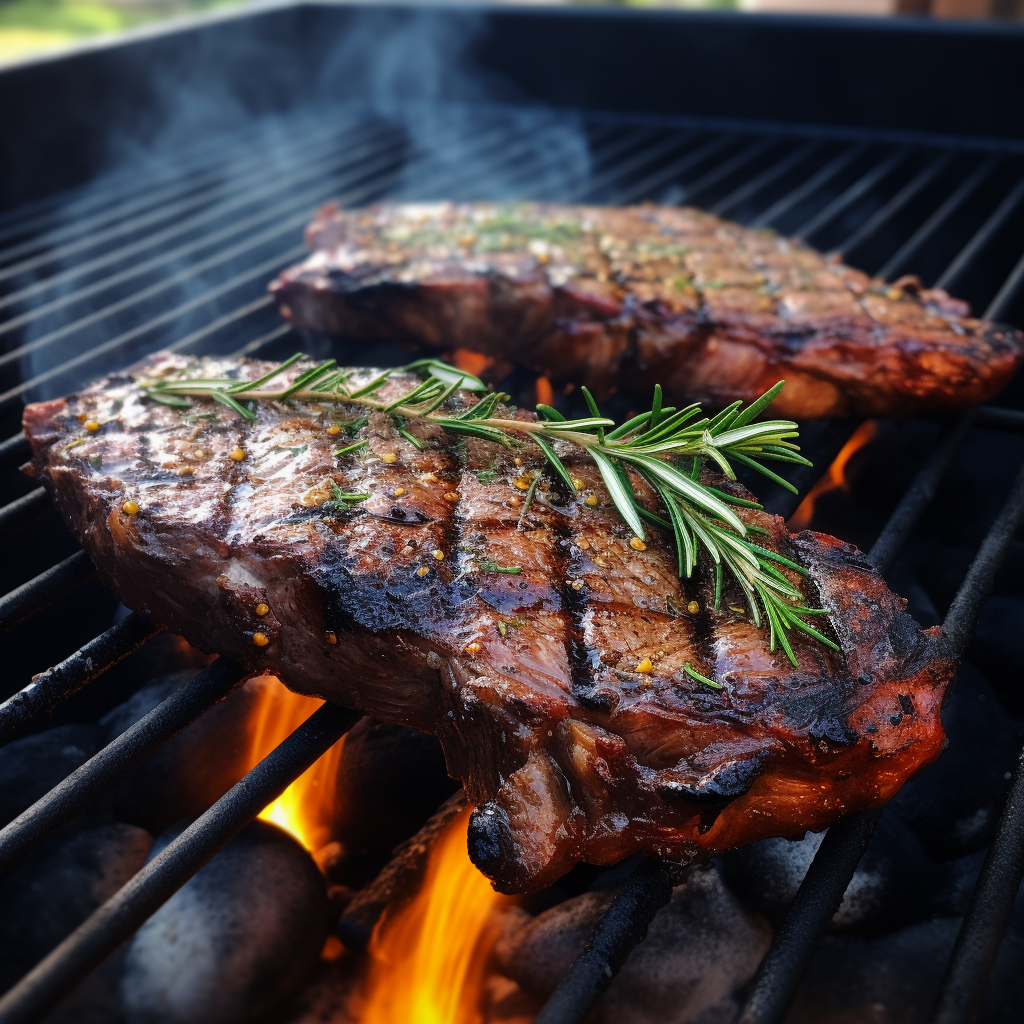
Conscientious consumers today seek assurance that their ribeye steak is succulent, high-grade, and sourced with ethical and sustainable practices in mind. Here are the key considerations to bear in mind when selecting your source:
Criteria for Ethical Ribeye Production
- Humane Treatment of Cattle: Ethical ranching practices prioritize the welfare of cattle, ensuring they have access to spacious pastures, clean water, and nutritious food, along with proper shelter.
- Environmentally Sustainable Farming Practices: Producers committed to sustainability adopt practices that protect the ecosystem. Techniques such as rotational grazing and the use of organic fertilizers over synthetic ones help maintain the health of the land.
- Natural Feeding Practices: The cattle’s diet should mimic what they would naturally graze on, predominantly grass and other forages, minimizing the use of grain-based feeds that are not native to their diet.
- Transparent Supply Chain: Ethical producers are transparent about their supply chain, offering clear labeling and traceability from the farm to your plate.
- Local Sourcing: By choosing locally sourced ribeye, you reduce the environmental impact of transportation and bolster local farming communities.
- Certifications and Labels: Certified Organic, Certified Humane, or Grass-fed are indicators of a producer’s commitment to ethical and sustainable practices.
Consumers can drive the market towards more responsible beef production by opting for ribeye that adheres to these standards. This ensures a product that excels in flavor and texture and supports the well-being of our environment and ethical animal husbandry.
Criteria for Ethical Ribeye Production
Embarking on the journey to ethically produced ribeye involves a multifaceted approach that respects the cattle’s welfare and the health of our planet. Here’s what to look for to ensure that your steak meets the highest ethical standards:
- Humane Animal Husbandry: At the heart of ethical ribeye lies the commitment to the cattle’s quality of life. This includes spacious environments that allow for natural behaviors, reducing stress and ensuring that the animals are treated with care and respect.
- Sustainable Farming Methods: Producers who embrace sustainability focus on conserving natural resources. They implement practices that minimize their carbon footprint and protect the integrity of soil and water. This includes the judicious management of livestock waste and limiting the use of harmful chemicals.
- Grazing Management: Ethical ribeye often comes from cattle that thrive on a grass-fed diet, roaming freely and grazing as nature intended. Techniques like rotational grazing not only benefit the cattle but also support the vitality of the grasslands.
- No Growth Hormones or Unnecessary Antibiotics: Ethical producers pledge to eschew growth hormones and avoid antibiotics unless they are essential for treating health issues. This approach prioritizes the health of the cattle and the end consumer.
- Environmental Stewardship: A commitment to the environment is a hallmark of ethical ribeye production. This means actively protecting wildlife habitats, enhancing biodiversity, and ensuring the farm’s activities harmonize with the surrounding ecosystem.
- Fair Labor Practices: Ethical considerations extend to those who work on the farms. This includes ensuring safe working conditions, fair compensation, and respect for workers’ rights.
- Certifications and Auditing: Third-party certifications and audits are often in place to validate these ethical practices. These serve as a seal of approval that the producer’s claims are not only promises but are put into practice.
By meeting these criteria, ribeye producers not only elevate the quality and flavor of their product but also align with the values of consumers who prioritize animal welfare and environmental responsibility. Order steaks online from We Speak Meat today.

